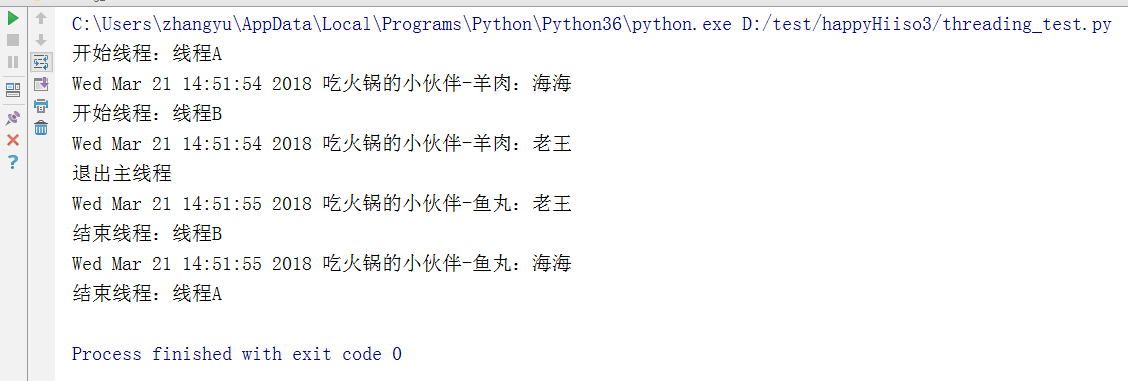python笔记8-多线程threading之封装式
执行函数
1.先写一个执行函数,用来实现做某件事情,不同的人吃火锅用一个参数people代替。
# coding=utf-8
import threading
import time
def chiHuoGuo(people):
print("%s 吃火锅的小伙伴-羊肉:%s" % (time.ctime(),people))
time.sleep(1)
print("%s 吃火锅的小伙伴-鱼丸:%s" % (time.ctime(),people))重写threading.Thread
1.使用Threading模块创建线程,直接从threading.Thread继承,然后重写__init__方法和run方法
# coding=utf-8
import threading
import time
class myThread (threading.Thread): # 继承父类threading.Thread
def __init__(self, people, name):
'''重写threading.Thread初始化内容'''
threading.Thread.__init__(self)
self.threadName = name
self.people = people
def run(self): # 把要执行的代码写到run函数里面 线程在创建后会直接运行run函数
'''重写run方法'''
print("开始线程: " + self.threadName)
chiHuoGuo(self.people) # 执行任务
print("结束线程: " + self.name)
![]()
start和run区别
1.start()方法 开始线程活动。
对每一个线程对象来说它只能被调用一次,它安排对象在一个另外的单独线程中调用run()方法(而非当前所处线程)。
当该方法在同一个线程对象中被调用超过一次时,会引入RuntimeError(运行时错误)。
2.run()方法 代表了线程活动的方法。
你可以在子类中重写此方法。标准run()方法调用了传递给对象的构造函数的可调对象作为目标参数,如果有这样的参数的话,顺序和关键字参数分别从args和kargs取得
参考代码
# coding=utf-8
import threading
import time
def chiHuoGuo(people):
print("%s 吃火锅的小伙伴-羊肉:%s" % (time.ctime(),people))
time.sleep(1)
print("%s 吃火锅的小伙伴-鱼丸:%s" % (time.ctime(),people))
class myThread (threading.Thread): # 继承父类threading.Thread
def __init__(self, people, name):
'''重写threading.Thread初始化内容'''
threading.Thread.__init__(self)
self.threadName = name
self.people = people
def run(self): # 把要执行的代码写到run函数里面 线程在创建后会直接运行run函数
'''重写run方法'''
print("开始线程: " + self.threadName)
chiHuoGuo(self.people) # 执行任务
print("结束线程: " + self.name)
# 创建新线程
thread1 = myThread("海海", "线程A")
thread2 = myThread("老王", "线程B")
# 开启线程
thread1.start()
thread2.start()
time.sleep(0.5)
print("退出主线程")
![]()
不急不躁,稳扎稳打




 浙公网安备 33010602011771号
浙公网安备 33010602011771号